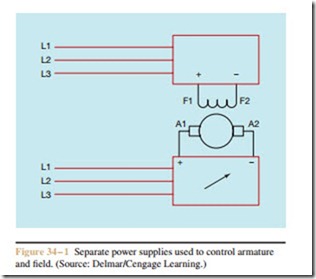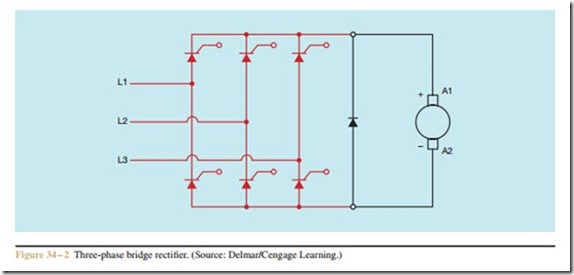Direct current motors are used throughout much of industry because of their ability to produce high torque at low speed, and because of their variable speed charac- L1 teristics. DC motors are generally operated at or below L2 normal speed. Normal speed for a DC motor is obL3 tained by operating the motor with full rated voltage
applied to the field and armature. The motor can be operated at below normal speed by applying rated voltage to the field and reduced voltage to the armature.
In Chapter 33, resistance was connected in series with the armature to limit current and, therefore, speed. Although this method does work and was used in industry for many years, it is seldom used today. When resistance is used for speed control, much of the power applied to the circuit is wasted in heating the resistors, and the speed control of the motor is not smooth be- cause resistance is taken out of the circuit in steps.
Speed control of a DC motor is much smoother if two separate power supplies, which convert the AC voltage to DC voltage, are used to control the motor in- stead of resistors connected in series with the armature (Figure 34 – 1). Notice that one power supply is used to Figure 34 – 1 Separate power supplies used to control armature and field. (Source: Delmar/Cengage Learning.)
supply a constant voltage to the shunt field of the motor, and the other power supply is variable and supplies voltage to the armature only.
The Shunt Field Power Supply
Most solid-state DC motor controllers provide a separate DC power supply, which is used to furnish ex- citation current to the shunt field. The shunt field of most industrial motors requires a current of only a few am- peres to excite the field magnets; therefore, a small power supply can be used to fulfill this need. The shunt field power supply is generally designed to remain turned on even when the main (armature) power supply is turned off. If power is connected to the shunt field even when the motor is not operating, the shunt field will act as a small resistance heater for the motor. This heat helps prevent moisture from forming in the motor due to condensation.

